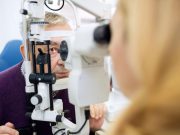Tag: Macular Degeneration
Amsler Grid Not Sensitive Enough for Diagnosing Neovascular AMD
Sensitivity was 67 percent, specificity was 99 percent compared with healthy controls
FDA Approves First Treatment for Geographic Atrophy
Pegcetacoplan approved as an injection with dosing every 25 to 60 days
U.S. Adults Lack Knowledge About Age-Related Macular Degeneration
Gaps in knowledge for the leading cause of adult blindness seen for symptoms, treatment
Two Disease Processes Contribute to Age-Related Macular Degeneration
Lesions from soft drusen/pigment epithelial detachments have lower mean quantitative autofluorescence, while those from subretinal drusenoid deposits have higher
Dietary Nitrate Intake Linked to Lower Risk for AMD Progression
Higher dietary nitrate intake linked to reduced risk for progression to late age-related macular degeneration
Bevacizumab, Aflibercept Compared for Neovascular AMD
At the end of one year, likelihood of being weaned off treatment was higher for eyes treated with aflibercept versus bevacizumab
Subretinal Drusenoid Deposits Linked to High-Risk Vascular Disease in AMD
Presence of HRVD can be identified in model including SDD, high-density lipoprotein with accuracy of 78.5 percent
Lipid-Lowering, Antidiabetic Drugs Tied to Prevalence of AMD
Use of lipid-lowering drugs, antidiabetic drugs associated with lower prevalence of any age-related macular degeneration
Age-Related Macular Degeneration Prevalence Remains High
1.49 million people aged 40 years and older are living with late-stage AMD in the United States
AAO: One in Nine Patients With Wet AMD Skip Follow-Up
Odds of being lost to follow-up greater among very old patients, Black and Hispanic patients, and Medicaid patients














